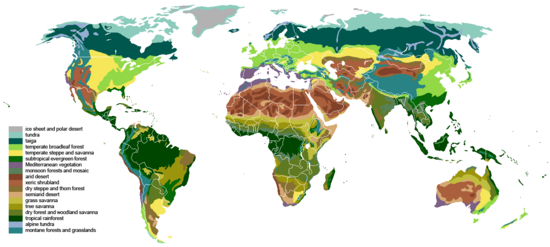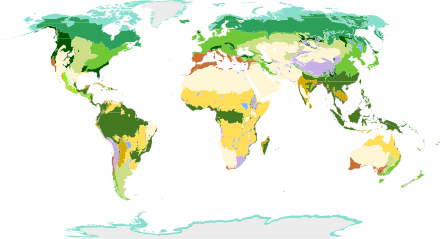बायोम
बायोम (अंग्रेजी: biome; IPA: [baɪoʊm]) कौनों प्राकृतिक आवासक्षेत्र (हैबिटाट) में पावल जाए वाला बनस्पति (फ्लोरा) आ जियाजंतु (फौना) के समेकित रूप होखे लें [1]दुसरे शब्द में, बायोम एगो बिसाल इलाका होला जेकर अपने खास बनस्पति, माटी, जलवायु आ जियाजंतु सभ से पहिचान होले।[2]

बायोम के बर्गीकरण के कई गो तरीका अपनावल गइल बाड़ें; मुख्य रूप से पाँच गो बायोम प्रकार गिनावल जालें: पनिहा (एक्वाटिक), घासमैदान (ग्रासलैंड), बन, रेगिस्तान आ टुंड्रा बायोम। हालाँकि, इनहन में से कुछ के अउरियो उपप्रकार में बाँटल जा सके ला।[2] जइसे कि, एक्वाटिक बायोम के फ्रेशवाटर बायोम (मीठापानी के बायोम) आ मरीन बायोम (समुंद्री बायोम) में बाँटल जा सके ला।
Olson & Dinerstein (1998) biomes for WWF / Global 200 संपादन करीं

A team of biologists convened by the World Wildlife Fund (WWF) developed a scheme that divided the world's land area into biogeographic realms (called "ecozones" in a BBC scheme), and these into ecoregions (Olson & Dinerstein, 1998, etc.). Each ecoregion is characterized by a main biome (also called major habitat type).[3][4]
This classification is used to define the Global 200 list of ecoregions identified by the WWF as priorities for conservation.[3]
For the terrestrial ecoregions, there is a specific EcoID, format XXnnNN (XX is the biogeographic realm, nn is the biome number, NN is the individual number).
Biogeographic realms (terrestrial and freshwater) संपादन करीं
- NA: Nearctic
- PA: Palearctic
- AT: Afrotropic
- IM: Indomalaya
- AA: Australasia
- NT: Neotropic
- OC: Oceania
- AN: Antarctic[4]
The applicability of the realms scheme above - based on Udvardy (1975)—to most freshwater taxa is unresolved.[5]
Biogeographic realms (marine) संपादन करीं
Biomes (terrestrial) संपादन करीं
- Tropical and subtropical moist broadleaf forests (tropical and subtropical, humid)
- Tropical and subtropical dry broadleaf forests (tropical and subtropical, semihumid)
- Tropical and subtropical coniferous forests (tropical and subtropical, semihumid)
- Temperate broadleaf and mixed forests (temperate, humid)
- Temperate coniferous forests (temperate, humid to semihumid)
- Boreal forests/taiga (subarctic, humid)
- Tropical and subtropical grasslands, savannas, and shrublands (tropical and subtropical, semiarid)
- Temperate grasslands, savannas, and shrublands (temperate, semiarid)
- Flooded grasslands and savannas (temperate to tropical, fresh or brackish water inundated)
- Montane grasslands and shrublands (alpine or montane climate)
- Tundra (Arctic)
- Mediterranean forests, woodlands, and scrub or sclerophyll forests (temperate warm, semihumid to semiarid with winter rainfall)
- Deserts and xeric shrublands (temperate to tropical, arid)
- Mangrove (subtropical and tropical, salt water inundated)[4]
Biomes (freshwater) संपादन करीं
According to the WWF, the following are classified as freshwater biomes:[7]
- Large lakes
- Large river deltas
- Polar freshwaters
- Montane freshwaters
- Temperate coastal rivers
- Temperate floodplain rivers and wetlands
- Temperate upland rivers
- Tropical and subtropical coastal rivers
- Tropical and subtropical floodplain rivers and wetlands
- Tropical and subtropical upland rivers
- Xeric freshwaters and endorheic basins
- Oceanic islands
Biomes (marine) संपादन करीं
Biomes of the coastal and continental shelf areas (neritic zone):
- Polar
- Temperate shelves and sea
- Temperate upwelling
- Tropical upwelling
- Tropical coral[8]
Summary of the scheme संपादन करीं
- Biosphere
- Biogeographic realms (terrestrial) (8)
- Ecoregions (867), each characterized by a main biome type (14)
- Biogeographic realms (terrestrial) (8)
- Biosphere
- Biogeographic realms (freshwater) (8)
- Ecoregions (426), each characterized by a main biome type (12)
- Ecosystems (biotopes)
- Ecoregions (426), each characterized by a main biome type (12)
- Biogeographic realms (freshwater) (8)
- Biosphere
- Biogeographic realms (marine) (12)
- (Marine provinces) (62)
- Ecoregions (232), each characterized by a main biome type (5)
- Ecosystems (biotopes)
- Ecoregions (232), each characterized by a main biome type (5)
- (Marine provinces) (62)
- Biogeographic realms (marine) (12)
Example:
- Biosphere
- Biogeographic realm: Palearctic
- Ecoregion: Dinaric Mountains mixed forests (PA0418); biome type: temperate broadleaf and mixed forests
- Ecosystem: Orjen, vegetation belt between 1,100 and 1,450 m, Oromediterranean zone, nemoral zone (temperate zone)
- Biotope: Oreoherzogio-Abietetum illyricae Fuk. (Plant list)
- Plant: Silver fir (Abies alba)
- Biotope: Oreoherzogio-Abietetum illyricae Fuk. (Plant list)
- Ecosystem: Orjen, vegetation belt between 1,100 and 1,450 m, Oromediterranean zone, nemoral zone (temperate zone)
- Ecoregion: Dinaric Mountains mixed forests (PA0418); biome type: temperate broadleaf and mixed forests
- Biogeographic realm: Palearctic
संदर्भ संपादन करीं
- ↑ "The world's biomes". www.ucmp.berkeley.edu. Archived from the original on 2008-12-04. Retrieved 2008-11-25.
is a large collection of flora and fauna occupying a major habitat.
- ↑ 2.0 2.1 "The Five Major Types of Biomes". nationalgeographic.org (अंग्रेजी में). National Geographic Society. 22 सितंबर 2020. Retrieved 26 जनवरी 2022.
- ↑ 3.0 3.1 Olson, D. M. & E. Dinerstein (1998). The Global 200: A representation approach to conserving the Earth’s most biologically valuable ecoregions. Conservation Biol. 12:502–515, [1] Archived 2016-10-07 at the Wayback Machine.
- ↑ 4.0 4.1 4.2 Olson, D. M., Dinerstein, E., Wikramanayake, E. D., Burgess, N. D., Powell, G. V. N., Underwood, E. C., D'Amico, J. A., Itoua, I., Strand, H. E., Morrison, J. C., Loucks, C. J., Allnutt, T. F., Ricketts, T. H., Kura, Y., Lamoreux, J. F., Wettengel, W. W., Hedao, P., Kassem, K. R. (2001). Terrestrial ecoregions of the world: a new map of life on Earth. Bioscience 51(11):933–938, [2] Archived 2012-09-17 at the Wayback Machine.
- ↑ Abell, R., M. Thieme, C. Revenga, M. Bryer, M. Kottelat, N. Bogutskaya, B. Coad, N. Mandrak, S. Contreras-Balderas, W. Bussing, M. L. J. Stiassny, P. Skelton, G. R. Allen, P. Unmack, A. Naseka, R. Ng, N. Sindorf, J. Robertson, E. Armijo, J. Higgins, T. J. Heibel, E. Wikramanayake, D. Olson, H. L. Lopez, R. E. d. Reis, J. G. Lundberg, M. H. Sabaj Perez, and P. Petry. (2008). Freshwater ecoregions of the world: A new map of biogeographic units for freshwater biodiversity conservation. BioScience 58:403–414, [3] Archived 2016-10-06 at the Wayback Machine.
- ↑ Spalding, M. D. et al. (2007). Marine ecoregions of the world: a bioregionalization of coastal and shelf areas. BioScience 57: 573–583, [4] Archived 2016-10-06 at the Wayback Machine.
- ↑ "Freshwater Ecoregions of the World: Major Habitat Types" "Archived copy". Archived from the original on 2008-10-07. Retrieved 2008-05-13.
{{cite web}}: CS1 maint: archived copy as title (link). Accessed May 12, 2008. - ↑ WWF: Marine Ecoregions of the World Archived 2009-02-07 at the Wayback Machine
| ई भूगोल-संबंधित लेख एगो आधार बाटे। जानकारी जोड़ के एकरा के बढ़ावे में विकिपीडिया के मदद करीं। |
| ई जीव बिज्ञान से संबंधित लेख एगो आधार बाटे। जानकारी जोड़ के एकरा के बढ़ावे में विकिपीडिया के मदद करीं। |
| ई पर्यावरण-संबंधी लेख एगो आधार बाटे। जानकारी जोड़ के एकरा के बढ़ावे में विकिपीडिया के मदद करीं। |